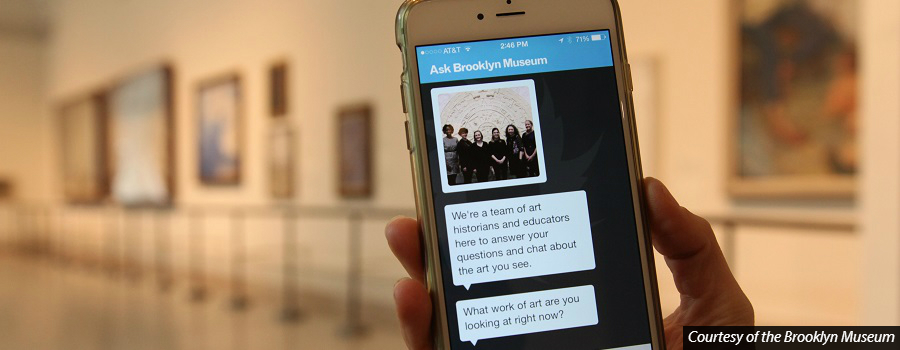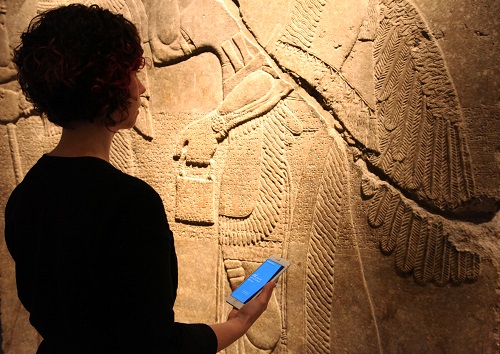Engaging with Visitors, When Visitors Have Superpowers: Testing the ‘ASK Brooklyn Museum’ App

More empowered than ever, visitors to art museums typically enter these institutions equipped with digital tools that can mediate their experience of the objects within. [1] With an interest in how technology like smartphones could impact curatorship, I accepted a position as a visitor liaison during the summer of 2015 at the Brooklyn Museum. Officials there were reimagining the entire visitor experience preceding Anne Pasternak’s assumption of the museum directorship in September 2015. In June 2015 the museum unveiled an original smartphone app called ASK Brooklyn Museum, which makes it possible to chat with museum experts at any point during a visit without delay. [2] It was my role to encourage museum-goers to put this tool to use.
Before joining the ranks of the Brooklyn Museum, I had previously worked for the Cooper-Hewitt, Smithsonian Design Museum, which, in early 2015, earned the title “The Museum of the Future” from The Atlantic because of its Pen, an interactive stylus lent to visitors at admission. [3] Pen users can tap museum labels to add information about an object to personalized webpages, which they access later, and they can sketch their own designs on digital tables, which scour the collection database for similar objects. Referring to smartphones, Pen project engineer Aaron Straup Cope admitted that “all the visitors arrive with superpowers,” but the Pen assembles diverse information for them without mediating the gallery encounter through a personal screen. [4]
While ASK Brooklyn Museum does require the use of a smartphone or a tablet, it delivers a simple and familiar interface with the fundamental capability of live communication. [5] When guests open the app, they immediately receive a prompt to begin a dialogue by sending a photograph or text message. The team of staff members that responds to them comprises art historians and educators specializing in different areas of the museum’s encyclopedic collection. While these experts often answer questions of subject and provenance, they also inspire close observation and discuss the users’ impressions of installations. Even with a minimal team on hand, this free app ensures that visitors to New York’s second-largest museum never enter a gallery without the option of an on-demand interpreter.

As an ASK Visitor Liaison, I worked with a separate group of staff to introduce the program to visitors and to evaluate how our pitches impacted usage rates. While we frequently shifted the precise locations at which we met potential “askers,” we polled them about prototypes for promoting ASK in the galleries. We crafted precise language for our messaging and tested attention-grabbing slogans like “stump our experts” or “it’s better than Google.” Throughout this systematic testing we were pleased that visitors consistently uttered “wow” when we told them that they would be chatting with real humans.
During the infancy of the live app, we discovered that while only about two percent of visitors used it, users at a wide variety of ages engaged deeply with the ASK team, averaging thirteen messages per visit. [6] Snippets, which are saved ASK conversations, have even provided invaluable feedback to curators, who are learning which questions visitors frequently ask and which objects provoke these queries.

Although ASK Brooklyn Museum has much growth ahead, I believe that the Brooklyn Museum is generating a novel type of community with the app’s interface. [7] Viewers shape the discussion around artworks of their choice, team members encourage meaningful discussion and offer institutional knowledge, and curators adapt interpretation based on these exchanges. Additionally, this groundbreaking initiative cuts costs by utilizing the ubiquitous platform of smartphones, presents manifold possibilities for future engagement, and does not collect any personal information from devices. Even so, we occasionally had to reassure wary Brooklynites that this app does not keep track of their whereabouts.
Steve Burges
____________________
Endnotes:
[1] Many institutions are currently evaluating technology initiatives, which the Wall Street Journal has skeptically grouped under the header of “the brave new museum.” Of course some museums have taken an opposing position, purposely investing in “no-tech” gallery activities: Lee Rosenbaum, “The Brave New Museum Sputters into Life,” The Wall Street Journal, September 7, 2015, accessed November 1, 2015; Amy Williamson, “Creating Wonder: A Discussion with Kristi McMillan, Assistant Curator of Education for Visitor Engagement at the Birmingham Museum of Art,” SEQUITUR 1, vol. 2 (2014), accessed November 1, 2015.
[2] The current edition of the app is testing on Apple devices only, but expansion to Android products is planned. It was developed internally with funding from Bloomberg Philanthropies. It can be downloaded here: https://itunes.apple.com/us/app/ask-brooklyn-museum/id949540325?mt=8
[3] The background technology of the Pen, which connects museum databases to each other and to the website, also helped the museum earn this title: Robinson Meyer, “The Museum of the Future Is Here,” The Atlantic, January 20, 2015, accessed November 1, 2015.
[4] In the first six months about one third of the Cooper-Hewitt’s visitors would visit their custom collection webpage. This number is actually quite successful compared to app engagement rates at major museums: Rosenbaum, “The Brave New Museum Sputters into Life;” Meyer, “The Museum of the Future Is Here.”
[5] Eighty-nine percent of Brooklyn Museum visitors own a smartphone, so it was not necessary to invest in rigid and expensive hardware for this program. Visitors can also talk to the ASK team in person, because they can be found at public workstations. Lee Rosenbaum, who took issue with technical glitches in several of the technology initiatives she tested, praised this app: “Avoiding the perils of experimental software and dead-end hardware, the Brooklyn Museum’s thoroughly satisfying ASK app relies on text messaging from visitors’ own Apple devices:” Shelley Bernstein, “Measuring Success,” brooklynmuseum.org, August 19, 2015, accessed November 1, 2015; Rosenbaum, “The Brave New Museum Sputters into Life.”
[6] The variety of users contradicts an implication made by the New York Times that museum tech initiatives are gimmicks for attracting the vital millennial audience. Shelley Bernstein also stated in a 2015 lecture that based on other major museum app usage rates, the percentage of early users were not as far behind as one might expect, especially considering that the app had not been advertised at that point: Michael Cannell, “Museums Turn to Technology to Boost Attendance by Millennials,” The New York Times, March 17, 2015, accessed November 1, 2015; Shelley Bernstein, “Exploring Ask at Brooklyn Museum” (paper presented at the Museum Next Conference, Indianapolis, Indiana, September 25-26, 2015).
[7] The ASK Brooklyn Museum project goal has always been: “To create a dynamic and responsive museum that fosters dialogue and sparks conversation between staff and visitors:” Shelley Bernstein, “Visitor Powered Technology to Create a Responsive Museum,” brooklynmuseum.org, September 9, 2014, accessed November 1, 2015.